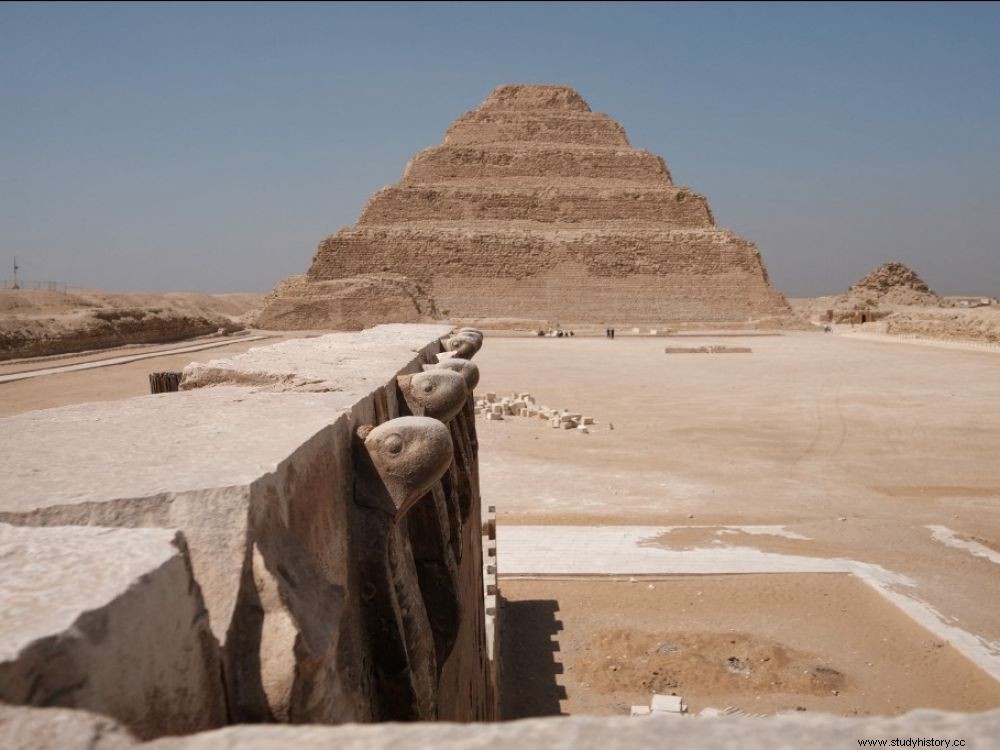Political, religious, security... The reasons that presided over the evolution of the pyramids, then their abandonment in favor of the hypogeums, remain hypothetical for Egyptologists.

Step Pyramid at Saqqara (Egypt).
This article is from the Special Issue of Sciences et Avenir n°197 dated April-May 2019.
Audran Labrousse is honorary director of research at the CNRS and member of the Franco-Swiss Archaeological Mission of Saqqara in Egypt. He answered questions from Sciences et Avenir .
Sciences et Avenir:What place do the pyramids occupy in the history of ancient Egypt?
Audran Labrousse: If I were a poet, I would say that they are the heart of eternal Egypt. First of all, because this type of structure is found throughout three thousand years of history! A longevity that concretely testifies to their importance. Then, because a question has always obsessed the Egyptians:access to the afterlife and eternity. In this respect, the pyramids mark, by their symbolic complexity and their monumental character, a break in the approach to life in the other world. The systematic use of cut stone is revealing:it arms the tomb for eternity. And protect Pharaoh's body forever.
Why did their shape change?
No source allows us to know how the pyramids were built exactly. And a fortiori to understand the reasons for their evolution. The question of the transition from the step pyramid to the pyramid with smooth faces has been bothering Egyptologists for a long time... But, let's be honest, we have no idea! Knowing that under a pyramid with smooth faces always hides a step pyramid, are we simply talking about an evolution due to the understanding of new technical elements? When a new dogma arises? Or both?
How to explain their disappearance at certain times?
This article is from the Special Issue of Sciences et Avenir n°197 dated April-May 2019.
Audran Labrousse is honorary director of research at the CNRS and member of the Franco-Swiss Archaeological Mission of Saqqara in Egypt. He answered questions from Sciences et Avenir .
Sciences et Avenir:What place do the pyramids occupy in the history of ancient Egypt?
Audran Labrousse: If I were a poet, I would say that they are the heart of eternal Egypt. First of all, because this type of structure is found throughout three thousand years of history! A longevity that concretely testifies to their importance. Then, because a question has always obsessed the Egyptians:access to the afterlife and eternity. In this respect, the pyramids mark, by their symbolic complexity and their monumental character, a break in the approach to life in the other world. The systematic use of cut stone is revealing:it arms the tomb for eternity. And protect Pharaoh's body forever.
Why did their shape change?
No source allows us to know how the pyramids were built exactly. And a fortiori to understand the reasons for their evolution. The question of the transition from the step pyramid to the pyramid with smooth faces has been bothering Egyptologists for a long time... But, let's be honest, we have no idea! Knowing that under a pyramid with smooth faces always hides a step pyramid, are we simply talking about an evolution due to the understanding of new technical elements? When a new dogma arises? Or both?
How to explain their disappearance at certain times?
Their birth coincides with great political stability. An explanation is therefore to be found in the successive weaknesses of Egyptian royalty. Very concretely, the construction of a pyramid is far from trivial:it is expensive, requires a considerable workforce and is part of the long term. Not to mention that, visible from afar, the pyramids are often the prey of looters... In other words, this type of business can only be carried out under a strong administration. The appearance of the hypogea, in the New Kingdom, seems to be part of this perspective:more discreet, dug into the rock, they are also less expensive and easier to protect... This being so, we must not forget that the Egyptian society, like religious dogmas, have changed over time. But difficult, for lack of evidence, to precisely appreciate the reasons for each evolution.
What can we now expect from research?
Two axes seem important to me. A first would precisely concern the periods after the Old Kingdom, in particular that of the First Intermediate Period (around 2200-2033 BC), an era of agitation and disorder which saw the end of the golden age of the pyramids. It so happens that the Franco-Swiss Archaeological Mission of Saqqara recently resumed the excavation of a pyramid from this period, that of King Qakarê-Ibi, ruler of the VIII th dynasty. He is, it seems, the last pharaoh to have engraved the Texts of the pyramids in its vault… The scientific project of the mission including in particular the research and the publication of the Texts of the pyramids VI e dynasty, finding a later version nearby would be an exceptional discovery!
The other project obviously concerns the pyramids of the Old Kingdom. Too many received ideas and fantasies still project a biased image of reality on Egypt. Science must strive to restore a more rigorous vision. In this regard, the ScanPyramids mission seems to me to be crucial for the future of Egyptology:subject to the indisputable laws of physics, it offers us an impartial approach to the history of monuments... and of Egypt.
By Jerome Pace
